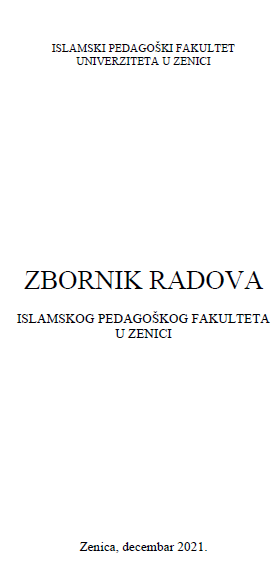PRILOG PROUČAVANJU POSTPOZICIJA, VEZNIKA I UZVIKA U DJELU DÎVÂNÜ LÜGÂTİ'T-TÜRK I SAVREMENOME TURSKOM JEZIKU
A CONTRIBUTION TO THE STUDY OF POSTPOSITIONS, CONJUNCTIONS AND INTERJECTIONS IN DÎVÂNÜ LÜGÂTİ'T-TÜRK AND MODERN TURKISH LANGUAGE
Author(s): Edina Solak, Mirza BašićSubject(s): Morphology, Semantics, Historical Linguistics, 6th to 12th Centuries, Philology, Turkic languages
Published by: Islamski pedagoški fakultet Univerziteta u Zenici
Keywords: postpositions; conjunctions; interjections; Dîvânü Lügâti’t-Türk; diachronic perspective;
Summary/Abstract: This paper analyzes morphological and semantic characteristics of postpositions, conjunctions and interjections in the philological encyclopedia Dîvânü Lügâti’t-Türk by Mahmud al- Kashgari. The analysis of grammatical and semantic structures of postpositions, conjunctions and interjections is based on an analytical and descriptive research method and a contrastive method. The analytical and descriptive research method describes grammatical characteristics of postpositions, conjunctions and interjections, while the contrastive analysis compares the grammatical and semantic structures of postpositions, conjunctions and interjections found in Dîvânü Lügâti’t-Türk to semantically similar lexemes or syntactic structures in the modern Turkish and Bosnian language. The results obtained from the analysis should contribute to better knowledge and understanding of grammatical and semantic structures of the Turkish language from a diachronic perspective, primarily because the analysis is based on concrete contextual examples from this philological encyclopedia containing all grammatical and semantical characteristics of Turkic languages in the 11th century. Actually, an analysis like this should contribute to better understanding of morphological and semantic characteristics of postpositions, conjunctions and interjections in the Turkish language and their semantic equivalents in the Bosnian language. The results obtained from the analysis can serve as a good foundation and a good starting point for further research of grammatical and semantic structure of Turkish from a diachronic perspective. The fundamental sources used for the analysis are the first and the third volume of the translation of Dîvânü Lügâti’t-Türk prepared by Besim Atalay.
Journal: Zbornik radova Islamskog pedagoškog fakulteta u Zenici
- Issue Year: 2021
- Issue No: 19
- Page Range: 431-448
- Page Count: 18
- Language: Bosnian

